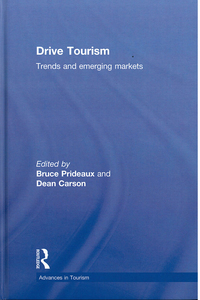Managing the transition from coach to car-based markets: the search for commercial value in Australia's Flinders Ranges
Schmallegger, Doris (2011) Managing the transition from coach to car-based markets: the search for commercial value in Australia's Flinders Ranges. In: Prideaux, Bruce, and Carson, Dean, (eds.) Drive Tourism: trends and emerging markets. Advances in Tourism . Routledge, Milton Park, UK, pp. 14-35.
![[img]](https://researchonline.jcu.edu.au/16460/1.hassmallThumbnailVersion/book_cover-Drive_Tourism.jpg)
|
Image (JPEG) (Book Cover)
- Cover Image
Download (1MB) |
|
|
PDF (Published Version)
- Published Version
Restricted to Repository staff only |
Abstract
[Extract] Remote destinations are fundamentally constrained by a lack of infrastructure and mass transport access, a lack of critical mass, and physical isolation from both markets and business partners (Hall and Boyd 2005). In Australia, changing consumer trends in the marketplace have further disadvantaged remote tourism destinations. Organised coach tourism, which used to dominate tourism activity in 'Outback' destinations throughout the 1980s and early 1990s, has experienced a decline over the past decade (Carson and Taylor 2009). As a result, these destinations find themselves increasingly more dependent on independent drive tourism markets. The former dependence on coach tourism has created an extensive homogenisation and a clustering of tourism products in and around a limited number of tourist centres. While this was a viable strategy when coaches brought large numbers of tourists on regular and geographically constrained schedules, the resultant approaches to product development, marketing and management are less well suited to drive tourists, who travel in smaller groups, are more geographically dispersed and seek experiences beyond scenery and icon attractions. Managing a successful transition from coach- to car-based markets requires innovative approaches to product development and marketing. The need for innovation has been described as critical to stimulate tourism in peripheral or remote regions (Carson and Taylor 2008; Sharpley 2002; Hohl and Tisdell 1995). Having the capacity to innovate allows the industry and the destination to adapt quickly to changing circumstances and to take advantage of new opportunities (Jacobsen 2005). An increasing body of literature suggests that one of the most effective ways to create innovations is by operating as a 'system of innovation' in which individual businesses, public organisations and institutions interact and influence each other (Iammarino 2005; Edquist 1997). How the mechanics of such 'systems of innovation' operate in the context of remote tourism destinations is still unclear. Due to their spatial and structural disadvantages, remote regions will understandably face more challenges and barriers to the development of successful innovation systems than urban or semi-urban regions (Doloreux and Dionne 2008). The diversity of the self-drive markets adds an additional layer of complexity that has not been considered in the literature to date. This chapter looks at the case of the Flinders Ranges, a relatively remote destination in South Australia that has experienced a strong decline in coach tourism and now has over 80 per cent of its market as self-drive tourists (South Australian Tourism Commission 2008). It analyses how the various components of successful 'systems of innovation' in tourism (Carson and Macbeth 2005) operate in a remote tourism destination and how this has influenced the destination's capacity to manage the transition from coach to self-drive tourism markets. After highlighting major issues in the Flinders Ranges, the chapter reflects on recent trends in self-drive tourism in remote regions and discusses the challenges associated with managing market transition. It will provide a brief review of 'systems of innovation' approaches, examining the individual components of the systems framework used in this study. The main part of the chapter will analyse the Flinders Ranges tourism system using Carson and Macbeth's 'systems of innovation' framework for regional tourism (Carson and Macbeth 2005) and finally outline the challenges and opportunities the destination faces as it seeks to manage successful market transition.
| Item ID: | 16460 |
|---|---|
| Item Type: | Book Chapter (Research - B1) |
| ISBN: | 978-0-415-49149-5 |
| Date Deposited: | 23 Jun 2011 01:47 |
| FoR Codes: | 14 ECONOMICS > 1402 Applied Economics > 140216 Tourism Economics @ 100% |
| SEO Codes: | 90 COMMERCIAL SERVICES AND TOURISM > 9003 Tourism > 900301 Economic Issues in Tourism @ 100% |
| Downloads: |
Total: 513 Last 12 Months: 1 |
| More Statistics |



